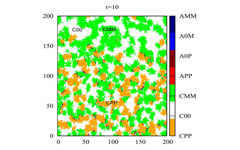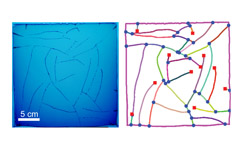Novel beams made of twisted atoms (Vol. 44 No. 5)
 'Snapshot' of atomic Bessel beam profiles.
'Snapshot' of atomic Bessel beam profiles.
Scientists can now theoretically construct atomic beams of a particular kind, which may apply in fields like quantum communication.
The present paper presents a theoretical construct of beams made of twisted atoms. These so-called atomic Bessel beams can, in principle, have potential applications in quantum communication as well as in atomic and nuclear processes.
The authors focused on a beam made of twisted two-level atoms, which are driven by a laser field. They created a theoretical construct by using an equation, referred to as the non-relativistic Schrödinger equation, for atoms which are moving much slower than the speed of light. The authors solved this equation by taking into account the propagation directions of both the atomic and laser beams. By superimposing a multitude of plane waves with well-defined amplitudes, they produced Bessel beams for two-level atoms that resonantly interact with the laser field.
A.G. Hayrapetyan, O. Matula, A. Surzhykov and S. Fritzsche, 'Bessel beams of two-level atoms driven by a linearly polarized laser field', Eur. Phys. J. D, 67, 167 (2013)
[Abstract]
Optical waveguide arrays (Vol. 44 No. 5)
 Centre or edge localization in tunable waveguide arrays.
Centre or edge localization in tunable waveguide arrays.
Over the past few years, advances in fabrication have made possible arrangements of coupled optical waveguides with tailored specifications. Such waveguide arrays are indispensible for building a scalable photonic quantum computer or creating novel optical elements.
The present paper summarizes the properties of light propagation in such an array with position-dependent coupling between adjacent waveguides. It shows that such arrays have properties that are markedly different from those of constant-coupling arrays. One such property is the formation of mirror-symmetric intensity profile in an array with a centre-maximum coupling profile. Another, shown in the figure, is the disorder-induced localization of a broad-input light to the centre of the array for centre-maximum coupling profiles and to the array edges, which occurs for centre-minimum coupling profiles.
These results, along with novel properties of light propagation in the presence of balanced, spatially separated absorption and amplification, indicate the wealth of tunability that is offered by coupled optical waveguides.
Y. N. Joglekar, C. Thompson, D. D. Scott and G. Vemuri
, ‘Optical waveguide arrays: quantum effects and PT symmetry breaking’, Eur. Phys. J. AP
[Abstract]
Passivated Tunneling Contacts for c-Si Solar Cells by Al2O3 and ZnO Nanolayers (Vol. 44 No. 5)
 Band diagram of the proposed novel front contact
Band diagram of the proposed novel front contact
Al2O3 nanolayers are well-known for their ability to reduce recombination losses at crystalline silicon surfaces, making Al2O3 an attractive material for passivation of the next-generation high efficiency solar cells. In this work, we try to take the application of Al2O3 one step further: when Al2O3 is deposited on n-type silicon, a high concentration of holes accumulates at the surface due to the high density of negative charges in the Al2O3. Consequently a pn-junction is formed which can replace the traditional front side p-doped region made by high temperature diffusion.
The idea presented in the article is to deposit a stack consisting of an Al2O3 and ZnO layer on the silicon. The holes separated from the electrons at the junction can tunnel through the Al2O3 into the transparent conductive ZnO where they are collected with minimal energy loss when the Al2O3 charge density and ZnO doping density are properly tailored. Using atomic layer deposition, it was demonstrated that Al2O3 and Al-doped ZnO films deposited with sub-nanometer precision can be used for this purpose with sufficiently high tunneling currents when the Al2O3 is about 1-2 nm thick.
D. Garcia-Alonso, S. Smit, S. Bordihn and W. M. M. Kessels,
‘Silicon passivation and tunneling contact formation by atomic layer deposited Al2O3/ZnO stacks’, Semicond. Sci. Technol. 28, 082002 (2013)
[Abstract]
Pulsating dust cloud dynamics modelled (Vol. 44 No. 6)
 Different phases of a self-gravitational potential
Different phases of a self-gravitational potential
New research outlines a new design of spatio-temporal models of astrophysical plasmas.
It is the collapse of dense molecular clouds under their own weight that offers the best sites of star formation. In the present work, the authors have proposed a new model for investigating molecular clouds fluctuations at sites of star formation and thus study their pulsational dynamics. They study the pulsating dynamics of inhomogeneous molecular clouds that periodically undergo both self-gravitational contraction due to the weight of the massive dust grains, and electrostatic expansion resulting from the interaction of dust grains of the same electric charge.
They designed a model for investigating the cloud fluctuations with charge-varying grains, as a function of weight and charge interaction (referred to as nonlinear gravito-electrostatic coupling). They then carried out a detailed shape analysis to characterize these clouds on the astrophysical scale.
P. K. Karmakar and B. Borah, ‘Nonlinear Pulsational Eigenmodes of a Planar Collisional Dust Molecular Cloud with Grain-charge Fluctuation’, Eur. Phys. J. D, 67, 187 (2013)
[Abstract]
Removing complexity layers from the universe’s creation (Vol. 44 No. 5)
 A schematic depiction of the combined motion that a Brownian particle executes in a background polycrystalline space.
A schematic depiction of the combined motion that a Brownian particle executes in a background polycrystalline space.
Understanding complexity in the early universe may require combining simpler models to interpret cosmological observations. The authors publish results pertaining to theoretical predictions of cosmological systems’ dynamics.
They found that the combination of Einstein’s special relativity and quantum-mechanical dynamics is mathematically identical to a complex dynamical system akin to two interlocked processes with different energy scales. To model it, the authors consider a quantum mechanical dynamics in a background polycrystalline space where particles exhibit a Brownian motion. The observed relativistic dynamics then comes solely from a particular grain distribution in this space. In cosmology, such distribution might stem from early universe’s formation.
This new interpretation focuses on the interaction of a quantum particle with gravity. The non-existence of the relativistic dynamics leads to a natural mechanism for the formation of particles-antiparticles asymmetry. When coupled with cosmology, the authors’ approach predicts that a charge asymmetry should have been produced at ultra-minute fractions of seconds after the Big Bang, in agreement with constraints born out of recent cosmological observations.
P. Jizba and F. Scardigli, ‘Special relativity induced by granular space’, Eur. Phys. J. C 73, 2491 (2013)
[Abstract]
Self-passivation of vacancies in α-PbO (Vol. 44 No. 5)
 Migration of oxygen vacancy towards lead vacancy followed by pair formation
Migration of oxygen vacancy towards lead vacancy followed by pair formation
Polycrystalline Lead Oxide (PbO) is one of the most promising materials for application in radiation medical imaging. At the current stage of technology, electronic grade PbO is not achievable because of large defect concentration. Defects act as traps for x-ray generated charge carriers during their transit across PbO layers: average distance drifted before trapping is smaller than layer thickness. Therefore, suppression of the effect of defects on carrier transport is an important challenge in PbO technology.
In metal oxides, vacancies are the main source of traps. The authors have shown that in thermally deposited PbO layers both Pb and O vacancies appear primarily in charged states of opposite sign. As a result, neighbouring vacancies can form neutral pair, which is no longer act as trapping centre. This finding offers a practical way to improve the transport properties. The post-growth annealing would initiate migration of the O vacancies towards Pb vacancies and facilitate their merging and neutral pair formation. The reduction in an amount of ionized centres increases carrier mobility and suppresses recombination thus improving x-ray generated charge collection.
J. Berashevich, J. A. Rowlands and A. Reznik, ‘Self-passivation of vacancies in α-PbO’, EPL, 102 (2013) 47002
[Abstract]
Semiclassical propagation up to the Heisenberg time (Vol. 44 No. 6)
 Long time propagation of a resonance in the hyperbola billiard. The Ehrenfest time is 2.2, and the Heisenberg time is 35.3
Long time propagation of a resonance in the hyperbola billiard. The Ehrenfest time is 2.2, and the Heisenberg time is 35.3
Semiclassical propagation of waves is a fruitful approach to understand and evaluate a wide set of physical processes. This is performed by associating quantum states with Lagrangian manifolds in phase space, and the propagation is accomplished by the evolution of manifolds. However, long time propagation in Hamiltonian systems with chaotic dynamics is a longstanding unsolved problem; the reason being that Lagrangian manifolds evolve into very complex objects.
Recently, we have shown that by using the stable and unstable manifolds of periodic orbits, the propagation is simplified enormously. For this reason, in this paper we study in detail the manifolds of a periodic orbit of the hyperbola billiard, finding that they are organized by a simple tree structure. Then, we compute a complete set of homoclinic orbits (resulting from the intersection of the manifolds), which is required to evaluate the autocorrelation function of a quantum state constructed in the neighborhood of the periodic orbit (resonance). Finally, we compare the quantum and semiclassical autocorrelation up to the Heisenberg time, finding a relative error of the order of the Planck constant.
E. G. Vergini, ‘Semiclassical propagation up to the Heisenberg time’, EPL, 103, 20003 (2013)
[Abstract]
Studying emotions causing opinions to change (Vol. 44 No. 5)
 Example of evolution of agent opinions.
Example of evolution of agent opinions.
Physicists can use their tools to help understand how, in real life, opinions form and change by modelling the complex interactions between information and emotion. Social phenomena fascinate with their complexity, but are not easily understood. The author of the present article has developed a model to study the dynamic of ‘agents’ and their response to a given piece of information, depending on their emotional state. He shows that opinion dynamics differ depending on whether the agent is agitated or not.
The premise for this study was to consider that a given agent opinion about a particular issue is determined by both its information about the issue and its subsequent emotional response. The author assumes the possibility of the same information leading to different opinions when agents are agitated. This results in an individual opinion dynamics.
The author’s findings, relevant to a simplified social environment, are directly comparable with social observations. These include the stability of minority groups surrounded by enemies and the fact that so many elections have results close to the 50/50 ratio.
P. Sobkowicz, ‘Minority persistence in agent based model using information and emotional arousal as control variables’, Eur. Phys. J. B, (2013)
[Abstract]
Topology of fluid drainage fracture networks (Vol. 44 No. 5)
 Drainage fractures in gelatine layer. Blue circles – nodes, red squares – dead ends.
Drainage fractures in gelatine layer. Blue circles – nodes, red squares – dead ends.
Fluid generation in rocks is a common phenomenon: generation of hydrocarbons (oil\gas) from source rocks during diagenesis, dehydration of sedimentary and metamorphic rocks during burial and partial melting of the Earth’s mantle. Fluid generation leads to local increase in fluid pressure. If the rate of fluid production is high compared to the rate at which fluids can escape by flow through the initial permeability, the fluid pressure increases and may cause fracturing and creation of new fluid transport pathways.
This paper presents the development of fracture networks in a simple quasi-2D system consisting of a confined layer of gelatine containing yeast that consumes sugar to produce CO2. The topological properties of the emerging fracture networks were found to be intermediate between the tree-like structure of river networks and the fragmentation cracking patterns observed in drying muds, domain splitting during rock weathering and fracturing of cooling basalts. The ratio of the number of dead ends to the amount of nodes is ~0.4, between the ratio for rivers (=1) and fragmentation crack patterns (=0). Understanding of fluid drainage network topology is crucial for uncovering the mechanisms which lead to its formation.
M. Kobchenko, A. Hafver, E. Jettestuen, O. Galland, F. Renard, P. Meakin, B. Jamtveit and D. K. Dysthe, ‘Drainage fracture networks in elastic solids with internal fluid generation’, EPL, 102, 66002 (2013)
[Abstract]
Universality in the symmetric exclusion process (Vol. 44 No. 6)
A system connected to two sources of heat or particles reaches, in the long time limit, a non-equilibrium steady state characterized by a non-vanishing and fluctuating current. Its study is an active topic in both classical and quantum systems. A relevant observable is the number Qt of particles flowing through the system during a time t. It can be calculated for simple models such as the symmetric simple exclusion process (SSEP), which describes two reservoirs at fixed densities connected by an L-site chain on which particles diffuse with a same site hard core repulsion. The corresponding cumulants of Qt are exactly known in one dimension and they coincide with those computed for the transport of free fermions through a mesoscopic conductor. We have generalized these results to arbitrary large but finite d-dimensional domains or graphs. Our numerical results indicate that, for large enough lattices and contacts to the reservoirs, the ratios of the cumulants of Qt take universal values, independent of the domain dimension and shape.
E. Akkermans, T. Bodineau, B. Derrida and O. Shpielberg, ‘Universal current fluctuations in the symmetric exclusion process and other diffusive systems, EPL, 103, 20001 (2013)
[Abstract]
When diffusion depends on chronology (Vol. 44 No. 5)
 Motorways are examples of nodes connected by edges studied as complex networks. (Photo Credit: Highways Agency)
Motorways are examples of nodes connected by edges studied as complex networks. (Photo Credit: Highways Agency)
The present work shows that the order of events taking place in complex networks may dramatically alter the way diffusion occurs in them. The Internet, motorways and other transport systems as well as many social and biological systems are composed of nodes connected by edges, and can be represented as networks.
Scientists studying diffusion over such networks over time have now identified the temporal characteristics that affect their diffusion pathways. In this paper, the authors show that one key factor that can dramatically change a diffusion process is the order in which events take place in complex networks.
They developed an analytical model to better understand the properties of time-dependent networks that either accelerate or slow down diffusion. Their study focused on different classes of popular models for diffusion, namely random walks and epidemic spread models, and found the way in which the temporal ordering of events matters. They expect these results to help in building more appropriate metrics to understand real-world complex network data.
R. Lambiotte, L. Tabourier and J.C. Delvenne, ‘Burstiness and spreading on temporal networks’, Eur. Phys. J. B (2013)
[Abstract]
X-rays emitted in neutron-induced fission of 238U(n,f) (Vol. 44 No. 6)
 Charge distribution determined from the x-ray yield measurements (symbols) for different incident neutron intervals. For more detail see text.
Charge distribution determined from the x-ray yield measurements (symbols) for different incident neutron intervals. For more detail see text.
Prompt x-rays emitted in neutron-induced fission help unveil the evolution of fission fragment charge yields as a function of incident neutron energy.
Nuclear fission is accompanied by the prompt emission of neutrons, gamma rays and x-rays. It has been known since the sixties that fission prompt x-rays originate essentially as a consequence of the internal conversions occurring in the prompt gamma deexcitation cascades of fission fragments.
This work presents for the first time a measurement of the prompt fission x-ray yields in 238U(n,f) for average incident neutron energies ranging from 3 to 200 MeV. Fission fragment charge distributions are derived from the measured x-ray yields using x-ray emission probabilities per fragment obtained in an earlier work on low energy fission. The results are found to be in a remarkable agreement with the Wahl phenomenological systematics for fission product yields, as well as with the more sophisticated GEF fission model. More detailed comparisons demonstrate that x-ray emission evolution with increasing incident neutron energy tends to be dominated by the transition towards lighter fragments which on average are closer to closed-shell nuclei and are thus less subject to internal conversion.
T. Granier, R.O. Nelson, T. Ethvignot, M. Devlin, N. Fotiades, P.E. Garrett and W. Younes, ‘Measurement of prompt X-rays in 238U(n,f) from threshold to 400MeV’, Eur. Phys. J. A 49, 114 (2013)
[Abstract]







